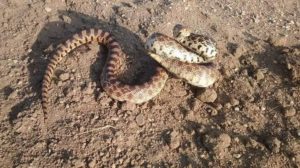One of the largest non-venomous snakes in the United States, the Bullsnake (Pituophis catenifer sayi) averages about 4 to 6 feet (1.2 to 1.8 m) in total length, and specimens of up to 8 feet 4 inches (2.5 m) have been recorded. The Bullsnake is a subspecies of the Gophersnake (Pituophis catenifer), which consists of 6 subspecies in total. Collectively the species is known as the “gophersnake”, with such familiar snakes as the San Diego Gophersnake and the Sonoran Gophersnake. The Bullsnake is the only subspecies without the name “gopher” attached to it ; this often leads to confusion and many people believe the bullsnake is a completely separate species, which is not the case.
Description ; The color pattern consists of a tan to light brown body with 41 to 66 brown, black or reddish brown blotches. On the sides, below the blotches are rows of similarly colored spots. Some specimens in Illinois and Indiana are very dark and can have a dark brown to black ground color with tan to yellow blotches. There are 27 to 37 rows of keeled dorsal scales. The chin and belly are pale yellow, and the belly has scattered black or brown mottled rectangles. The scales are heavily keeled and the anal plate is single. Young Gopher Snakes have a pattern similar to adults, but their coloration is lighter.
The Bullsnake is native to a large area from northern Mexico, through the great plains, and into parts of Canada. (see map)

Bullsnakes are often found wherever rodents are plentiful, and are considered rodent control experts. Ground squirrels are a favorite prey of the bullsnake. Other than rodents, bullsnakes are known to eat birds and bird eggs. A few studies of stomach contents revealed lizard eggs and a snake, but these are likely uncommon prey items. Bullsnakes kill their prey by constriction and often pursue prey by digging through loose soil, using the prominent rostral (nose) scale to do so.
Habitat included prairie grasslands, brushy area, fields, forest edges, and savannas. Unfortunately, in some parts of their range, such as the upper midwest, grasslands are disappearing and bullsnakes are losing foraging, breeding, and overwintering areas. Consequently those bullsnake populations have declined significantly over the past several decades and stable populations have been documented at only one or two sites in Wisconsin.
Throughout their range bullsnakes are frequently mistaken for rattlesnakes due to a somewhat similar pattern and dramatic defensive display. When approached the bullsnake will often raise part of their body off the ground in a classic “S” position, hiss loudly, and also vibrate their tail.

The hissing sound is produced when the snake forcibly exhales through a glottis or extension of the windpipe. The end of the glottis is covered by a piece of cartilage known as the epiglottis which flaps back and forth when air is exhaled from the right lung, producing a convincing rattling sound. However, it should be noted that the bullsnake is not “imitating” a rattlesnake, rather, they are using a defensive display that works and helps them survive. These behaviors likely evolved in snakes long before rattlesnakes appeared, including tail shaking, which probably later evolved into the rattle we are all familiar with.
Bullsnakes often use existing animal burrows as shelter and as an overwintering spot. This species is also known to spend the winter in multi-species dens alongside other snakes such as timber rattlesnakes, ratsnakes, and racers. These dens are often deep within rock fissures and crevices. Bullsnakes mate in the spring and the males may fight each other in a “test of strength” to determine who mates with the female.

The female bullsnake digs a hole for her eggs under a log or large rock and deposits 3-24 eggs in late spring or early summer. The baby bullsnakes are born without any care from the mother and are ready to spread out and find their first meal. Baby and juvenile bullsnakes often fall prey to mammals, birds, and other reptiles. Large adult bullsnakes have very few predators.
Important things to consider :
- Bullsnakes are an important part of the ecosystem and prey on large numbers of rodents
- Young bullsnakes are often prey for other species in the ecosystem
- Having a bullsnake on your property is highly beneficial
- Bullsnakes put on a dramatic defensive display but rarely bite
- Bullsnakes don’t chase or attack people. They can be observed safely and can be a great learning opportunity for children
Thanks for reading!